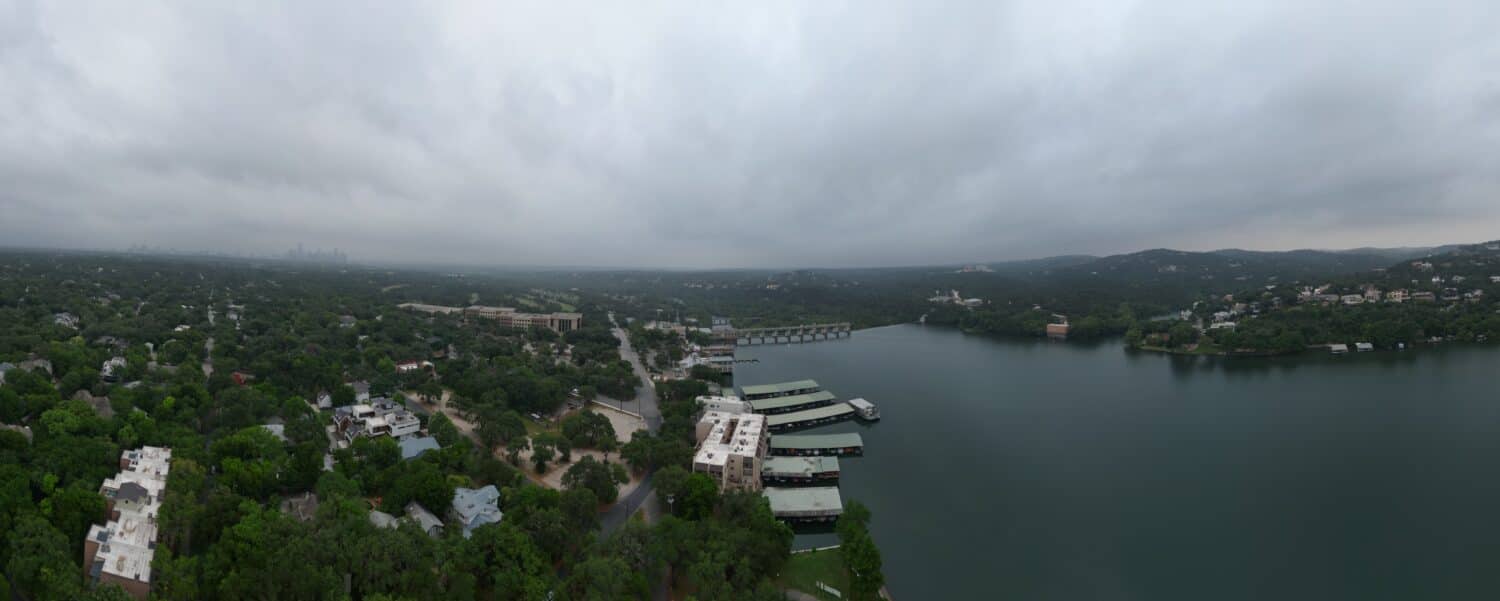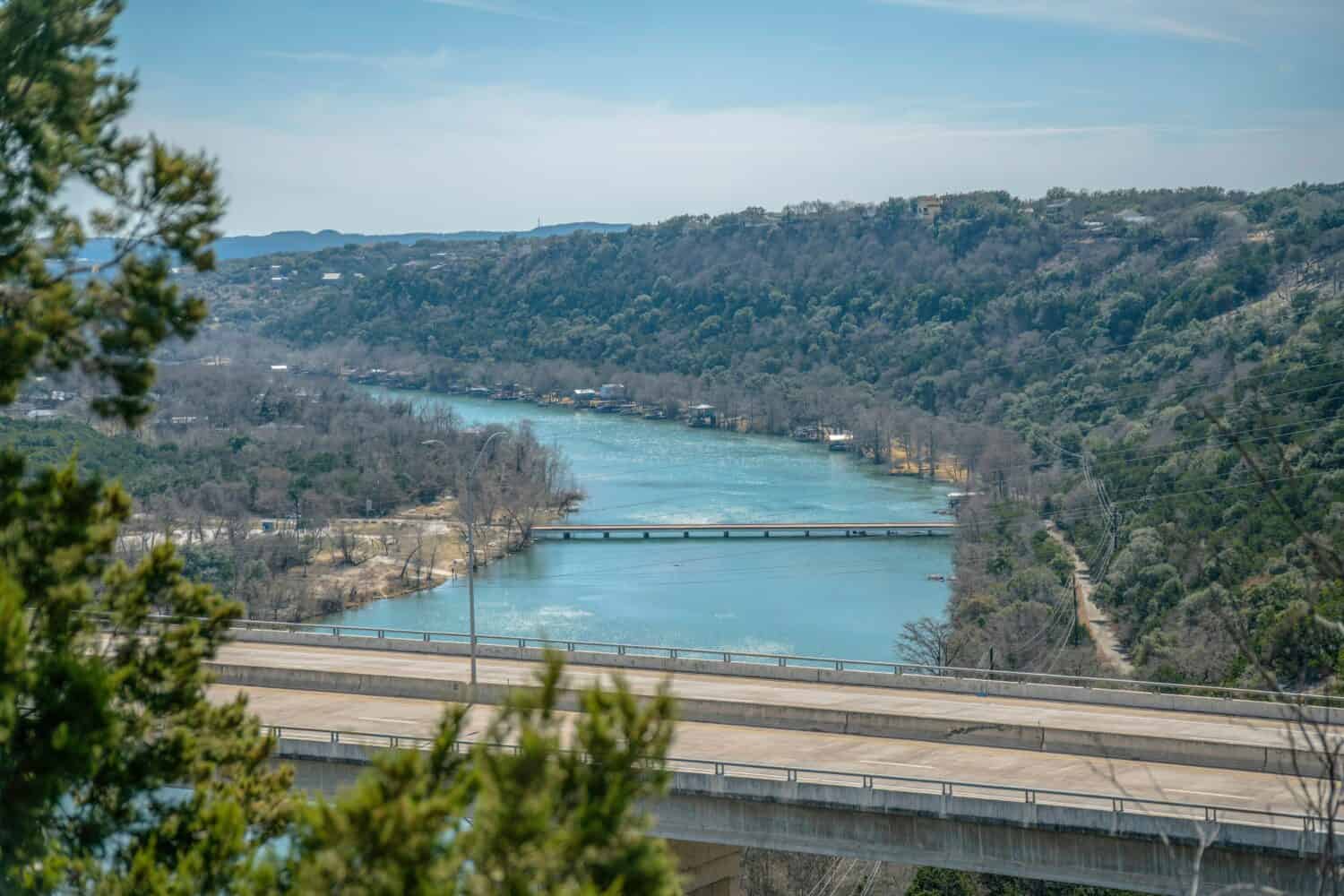Texas is home to a wide assortment of waterways even though the western portion of the state is semi-arid. The Rio Grande, the Red River of the South, and the Brazos River all run for over 1,000 miles within the state. The Colorado River flows for 862 miles through the state, and a sizable portion of that river was dammed, forming Lake Austin. How wide is Lake Austin and how large is it? Discover the size of this lake, its history, and more!
About Lake Austin

Lake Austin at the Tom Miller Dam.
©Airwave Dynamics/Shutterstock.com
Lake Austin is not a typical lake. Technically, the lake is a part of the Colorado River that has been dammed at both ends. The Lower Colorado River Authority (LCRA) dammed several parts of the Colorado River creating a total of 6 major lakes, including Lake Austin. Together, these lakes are called the Texas Highland Lakes. They are a series of freshwater reservoirs managed by the Lower Colorado River Authority.
The original Austin Dam was built between 1890 and 1893, resulting in the construction of Lake McDonald. However, the Austin Dam gave way in 1900 following a powerful storm. The builders only partially rebuilt the dam between 1909 and 1912. By 1915, the project was abandoned and then later washed away by another powerful rainstorm.
The city of Austin gave the LCRA the contract to build the new dam, and they completed the Tom Miller Dam in 1939. The new lake formed by that dam was named Lake Austin, and it has been in place ever since. The lake’s inflow is located to the northwest of Austin at Lake Travis, and it ends at the Tom Miller Dam. The Tom Miller Dam is a hydroelectric generation facility that also controls the flow of water into Lady Bird Lake.
Lake Austin is a water reservoir made to help control flow on the lower Colorado River while also generating hydroelectric power. Today, the lake is also a popular destination for recreational boating and fishing.
How Wide is Lake Austin?

Austin Lake as it winds through Texas.
©Jason Finn/Shutterstock.com
Lake Austin is about 1,300 feet wide at its greatest width. This lake is not very wide since it was originally a portion of the Colorado River. Also, it’s about 22 miles long. The lake has a total surface area of between 1,599 and 1,830 acres. The lake is reportedly 75 feet deep at its greatest depth.
Lake Austin is stocked with several fish species, and it’s well-known for largemouth bass and catfish. However, the lake also utilized grass carp to help control the invasive hydrilla plants. Unfortunately, the officials in charge of the plan either stocked too many of the non-native fish or the fish ate more than they anticipated. As a result, the fish consumed the hydrilla as well as plants that other fish feed on and use for cover.
Lake Austin is not very wide due to it being a meandering 22-mile section of the Colorado River. Many parts of the lake are surrounded by residential properties. However, much of the lake is still open to the public via boat ramps.
Where is the Lake on a Map?
Finding Lake Austin on a map is not that difficult. The lake flows on the Colorado River between the JJ Mansfield Hydroelectric Dam and the Tom Miller Dam. Generally, the river flows from the northwest to the southeast along its flow.
The lake is northwest of its namesake city. However, the lake ends its flow on the outskirts of the city. The portion of the river that flows through Austin is another lake called Lady Bird Lake. So, finding Lake Austin on a map is a simple matter of locating the flow of the Colorado River in Austin and following it to the northwest.
How Does Lake Austin Compare to Other Large Lakes?

Lake Superior is several hundred times wider than Lake Austin.
©iStock.com/troutnut
Lake Austin is not the largest lake in Texas by any measure. Other lakes are deeper, wider, and longer. Many others have a greater surface area than this lake even within the state. Take a look at some of the most well-known lakes in North America and see how they compare to Lake Austin in terms of width and length.
| Lake | Width | Surface Area |
|---|---|---|
| Lake Austin | 0.24 miles (1,300 feet) | 2.5 square miles |
| Lake Superior | 159.7 miles | 31,700 square miles |
| Great Salt Lake | 27.96 miles | 1,699 square miles |
| Lake of the Woods | 56 miles | 1,679 square miles |
| Iliamna Lake | 22 miles | 1,012 square miles |
Lake Austin does not compare to some of the biggest, most famous lakes in North America. Still, the lake is an important body of water in Texas.
How Long Would It Take a Swimmer to Cross the Widest Part of Lake Austin?

The average swimmer would take about 7.38 minutes to cross the widest portion of the lake.
©l i g h t p o e t/Shutterstock.com
The average person can swim at a speed of roughly 2 mph. The lake is about 1,300 feet wide at its widest point. A person swimming at 2 mph is traveling at about 2.93 feet per second. That means it would take a swimmer about 443.23 seconds to cross the lake if they were swimming at a consistent speed of 2 mph, it would take them roughly 7.38 minutes to cross the lake.
Swimming across Lake Austin may not be the best idea, though. While the lake is not that wide, it does have a lot of boats moving through the area. A swimmer could be harmed by a passing boat.
Although Lake Austin is a long lake, it’s not a wide one. The lake is only 1,300 feet wide at the greatest width. However, the lake is over 20 miles long. The lake is useful for generating hydroelectric power and reducing the potential for flooding along the Colorado River. It’s also a popular destination for water recreation!
Thank you for reading! Have some feedback for us? Contact the AZ Animals editorial team.








